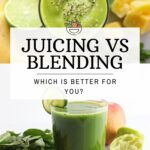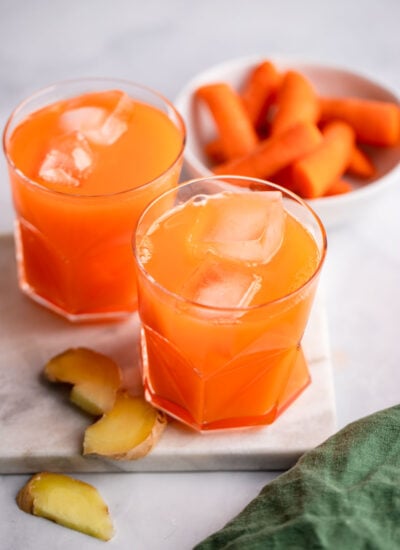Adding more fruits and vegetables to your diet when you are short on time can be difficult. Juices and smoothies are quick and convenient but you may be wondering which one is better? Here’s a dietitian’s perspective on which you should choose.

According to CDC, the majority of people in the US don’t get enough fruits and vegetables in their diet. In fact, they found that overall only 13% of people are meeting the 1-1.5 cups of fruit daily recommendation and just 8.9% met the 2-3 cups of vegetables per day recommendation.
Juices and smoothies can be an option for adding more fruits and vegetables to your diet but which one you choose depends on your health goals. As a registered dietitian, I think there is value in either one that you choose. Let’s talk about it!
What is Juicing?
Juicing means that you are simply squeezing out the nutrients and water from a fruit or vegetable and discarding the skin, seeds, and pulp. The nutrient composition of the juice will vary based on the produce used to make the juice.
Sipping on a glass of juice can be a convenient way to fit in another serving of fruit or vegetables. The USDA considers an 8 ounce glass of 100% fruit juice to be equivalent to one serving of whole fruit.
Be wary of juice “cleanses” or detoxes. There is nothing magical about juicing. The liver, kidneys, and digestive system do a great job of getting rid of any compounds that your body doesn’t need.

Pros of Juicing
- Juices can be as vitamin and mineral dense (sometimes more) as a smoothie.
- Juices are also a concentrated source of polyphenols. Polyphenols help protect the cells in your body from the oxidative damage that leads to chronic diseases like heart disease, type 2 diabetes, and cancer.
- Juices have a high water content so they can help you stay hydrated.
- If you don’t like veggies, juices made from vegetables combined with fruit for sweetness or a strongly flavored ingredient like ginger may be more appealing to you.
Cons of Juicing
- Juices lack fiber and protein and are low in calories so they won’t keep you feeling full for long. If you aren’t careful, they can also be a major source of sugar in your diet.
- Juice can be a bit pricey since you have to use a lot more fruits and vegetables to make a glass of juice rather than a smoothie.
- Juicers can be expensive and making juice at home with a blender and then filtering through a mesh bag can be tedious.
- Juicing can create food waste if the pulp is discarded rather than used in a recipe like crackers.

What is Blending?
Smoothies are an easy way to incorporate more fruits and vegetables into your day. Since everything is simply pureed, you still maintain all of the healthy fiber from the produce. Like juices, smoothies can also be high in sugar depending on what ingredients are used.
Smoothies can be filling enough to consume as a meal or post-workout recovery, unlike juices which should supplement a meal or snack.
Pros of Blending
- All the healthy fiber (both soluble and insoluble) from the fruits and vegetables is included when you make a smoothie.The health benefits of a higher fiber diet include lower bad cholesterol and reduced risk of heart disease, lower cancer risk, etc.
- Smoothies can be a good source of protein as well since you can incorporate milk, yogurt, nut butters, protein powder, and more.
- For those who don’t like the flavor of vegetables, adding greens to a smoothie may be an option since it can mask the bitter flavors. Even kids who are picky eaters love green smoothies according to this study.
Cons of Blending
- Too many sugary ingredients in your smoothie could turn a healthy option into an unhealthy one. Incorporate protein and healthy fats into your smoothie to make it more filling and smooth out the effects on your blood sugar.
- Adding vegetables like leafy greens to smoothies can turn a smoothie into an unappetizing shade of brown.

Which is Better for You?
It all depends on your health goals. Choose a smoothie when you are looking for a healthy meal that you can easily take with you on-the-go in the morning. Since it is so low in calories, juice makes a better snack or beverage rather than a meal replacement.
Both juicing and blending can be a great way to help you reach your daily fruit and vegetable intake goals. They both offer tons of nutrients and can be incorporated into a healthy diet.
Just keep in mind that you should try to avoid leaning too heavily on juices since they are lacking in important gut-healthy fiber. According to the USDA, at least half of the recommended amount of fruit you consume should come from whole fruit rather than juice.
Tips for a Healthier Homemade Juice
- Use more vegetables than fruit. Fresh greens like romaine lettuce, kale, or spinach make a great base for green juices. You can also use other vegetables like beets or carrots in juices for a beautiful color and natural sweetness.
- Add ginger or fresh turmeric for extra flavor as well as a boost of healthy anti-inflammatory compounds.
- Use tea instead of water when making your juice in a blender for a bit of caffeine and extra health benefits. I like using green tea in my homemade juices.
Tips for Making a Healthier Smoothie
- Sneak in some heart healthy fats by adding chia seeds, hemp hearts or ground flax which are all good sources of plant-based Omega 3 fats.
- Get in a serving of vegetables by adding veggies to your morning smoothie as well as fruit. Spinach isn’t the only veggie that works well in smoothies – try frozen cauliflower, cooked beets, or pumpkin puree.
- Bump up the protein by adding your favorite protein powder. Personally, I like this plant-based protein powder from Ritual.
- If using a plant-based milk, use one that contains protein like soy milk or milk made from peas so that morning smoothie keeps you full longer.
Juice and Smoothie Recipes
Check out my other match up posts!
- Seitan vs Tofu: Both of these are great alternatives for meat when going plant-based but one of them has twice as much protein per serving. Read the post to find out which one!
- Black Beans vs Pinto Beans: Beans are one of my favorite super foods but they are often overlooked. Packed with fiber and protein, you’ll want to check out the recipes I included in this post.
- Flaxseeds vs Chia Seeds: Incorporate just a couple tablespoons of flaxseeds or chia seeds in your diet for a boost of extra fiber and heart healthy omega 3 fat.
- Sunflower Butter vs Peanut Butter: Peanut butter is super popular, but there are so many other nut and seed butters on the market. Find out how sunflower butter stacks up.














Comments & Reviews
Thanks a lot, Debie! I’m glad you cleared this out since many people are confusing these two.
I’d like to add that smoothies aren’t suggested for juice fasting. When someone is on a juice fasting detox program, the goal is to skip the digestion completely, so fiber is not welcome.
Thanks again and keep it up!
Great post! I have a few people in mind who really need to read this 🙂
Great explanation of a commonly asked question!
Great explanation of the pros and cons of both and how juices aren’t a good meal replacement!
What a great post! This is a question I get asked on almost a daily basis by clients- thanks for clearing things up for others- definitely will be sharing this 🙂